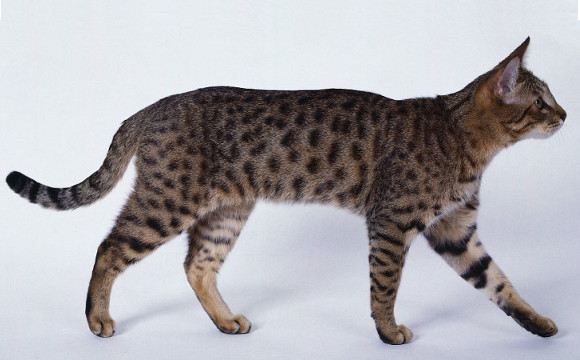The California Spangled Cat is a distinctive and rare breed, celebrated for its striking resemblance to wild felines and its fascinating history. This article provides an in-depth exploration of the breed’s origins, physical characteristics, personality, health considerations, care requirements, and its role in conservation efforts. By the end, you’ll have a thorough understanding of what makes the California Spangled Cat unique and why it holds a special place in the world of domestic cats.
History and Origins
The California Spangled Cat’s journey began in the 1980s, spearheaded by Paul Casey, a physicist and screenwriter. Inspired by a discussion with anthropologist Dr. Louis Leakey about leopard conservation, Casey envisioned a domestic cat that looked like a mini-leopard. His goal was to raise awareness about wild cat preservation through this breed.
Casey started with a Traditional Siamese and a spotted silver Angora, then introduced various other breeds such as the British Shorthair, American Shorthair, and Abyssinian to achieve the desired look. Street cats from Malaya and Egypt were also included to infuse a primitive and wild appearance. The breeding process was meticulous, aiming for both the physical attributes and a temperament suitable for domestic life.
In 1985, Casey established the California Spangled Cat Association to promote the breed and conservation efforts. The breed gained significant attention through a high-profile campaign in the Neiman-Marcus Christmas catalog in 1986, highlighting its exotic appearance and conservation message.
Physical Characteristics
The California Spangled Cat is renowned for its wild, leopard-like appearance. Key physical traits include:
- Spots: The hallmark of the breed, spots can be round, square, oval, or triangular. These spots are well-defined and give the cat its distinctive wild look.
- Body: The breed boasts a strong, muscular build with a hunter-like gait, reflecting its athleticism.
- Coat: The fur is soft, close-lying, and comes in various color patterns, including the rare Snow Leopard phase, which is a recessive trait.
- Head and Face: They have a broad, prominent muzzle, high cheekbones, and expressive eyes that give them an alert and intelligent expression.
- Tail: Medium to long, with a tapering end, often featuring rings or spots.
The overall appearance is that of a small wild cat, blending elegance and power.
Personality and Temperament
California Spangled Cats are not just about looks; they possess a dynamic and engaging personality. Here are some key traits:
- Affectionate and Social: These cats are known for their affectionate nature. They bond closely with their human companions and are often described as social butterflies.
- Intelligent and Curious: Highly intelligent, they are quick learners and enjoy exploring their environment. Puzzle toys and interactive play are essential to keep them mentally stimulated.
- Active and Athletic: With their muscular build, these cats are incredibly agile and enjoy climbing, running, and jumping. They need plenty of physical exercise to stay healthy and happy.
- Observant and Watchful: They like to perch at human eye level to observe their surroundings. This trait, combined with their alertness, makes them excellent at noticing changes in their environment.
Their strong hunting instincts mean they are easily intrigued by moving objects, and they often display playful behaviors well into adulthood.
Health Considerations
California Spangled Cats are generally healthy, but like all breeds, they may be prone to certain health issues. Regular veterinary check-ups are crucial to ensure their well-being. Some common health concerns include:
- Genetic Conditions: Due to their diverse genetic background, they may be susceptible to specific inherited conditions. Responsible breeding practices aim to minimize these risks.
- Obesity: Like many active breeds, if not provided with adequate exercise, California Spangled Cats can become overweight. Monitoring their diet and ensuring regular physical activity is essential.
- Dental Health: Regular dental check-ups and cleanings are important to prevent periodontal disease, which is common in many cat breeds.
- Skin and Coat Health: Maintaining their coat through regular brushing helps reduce shedding and prevents skin issues. A healthy diet also contributes to a shiny, well-kept coat.
Care and Maintenance
Owning a California Spangled Cat requires dedication to their physical and emotional well-being. Here are some key aspects of their care:
- Diet: Provide a balanced diet rich in high-quality protein. Consult with your veterinarian to determine the best food for your cat’s age, health, and activity level.
- Exercise: These cats are highly active and require plenty of physical exercise. Interactive toys, climbing structures, and daily play sessions are essential to keep them engaged.
- Grooming: Regular brushing helps maintain their sleek coat and reduces shedding. Checking their ears, teeth, and claws regularly is also important for their overall health.
- Social Interaction: California Spangled Cats are social and thrive on interaction with their human companions. Ensure they have plenty of opportunities for play and bonding.
Breeding and Population
The development of the California Spangled Cat was a slow process due to the need for precise genetic combinations. The breed remains rare, with a worldwide population under 200. Breeders continue efforts to increase their numbers while maintaining the breed’s unique characteristics. These efforts are crucial for the breed’s sustainability and recognition in cat shows and competitions.
Conservation Efforts
Paul Casey’s vision for the California Spangled Cat extended beyond creating a unique breed; it was also about raising awareness for wild cat conservation. The breed’s resemblance to wild felines was intended to highlight the plight of endangered species and promote conservation efforts. Casey’s work, coupled with the publicity generated by the breed, helped draw attention to illegal poaching and habitat destruction, contributing to broader conservation initiatives.
The California Spangled Cat in Popular Culture
Despite its rarity, the California Spangled Cat has made notable appearances in popular culture. Its exotic appearance and conservation message have been featured in various media, including advertisements and documentaries. These appearances have helped elevate the breed’s profile and spread awareness about its unique qualities and the importance of wild cat conservation.
Choosing a California Spangled Cat
If you are considering adding a California Spangled Cat to your family, it’s important to work with reputable breeders who prioritize the health and well-being of their cats. Here are some tips for choosing a California Spangled Cat:
- Research: Learn about the breed’s characteristics, care requirements, and potential health issues. Understanding the breed will help you make an informed decision.
- Visit Breeders: Visit breeders in person to see their cats and facilities. A reputable breeder will be transparent about their breeding practices and happy to answer your questions.
- Ask for Health Records: Ensure that the breeder provides health records for the kitten and its parents. This information is crucial for understanding the cat’s health background.
- Consider Adoption: While rare, there may be opportunities to adopt a California Spangled Cat through breed-specific rescues or adoption programs.
Conclusion
The California Spangled Cat is a remarkable breed that combines the allure of wild felines with the companionship of domestic cats. Their unique history, striking appearance, and engaging personality make them an excellent choice for cat enthusiasts who appreciate both aesthetics and conservation. With proper care, these cats can thrive and continue to serve as ambassadors for wild cat preservation.
By understanding and supporting the California Spangled Cat, you contribute not only to the well-being of a beautiful breed but also to the broader efforts of wildlife conservation. Whether you’re a seasoned cat owner or new to the world of exotic breeds, the California Spangled Cat offers a rewarding and enriching experience.
For more information and resources, visit the original article on California Spangled Cat Breed.

